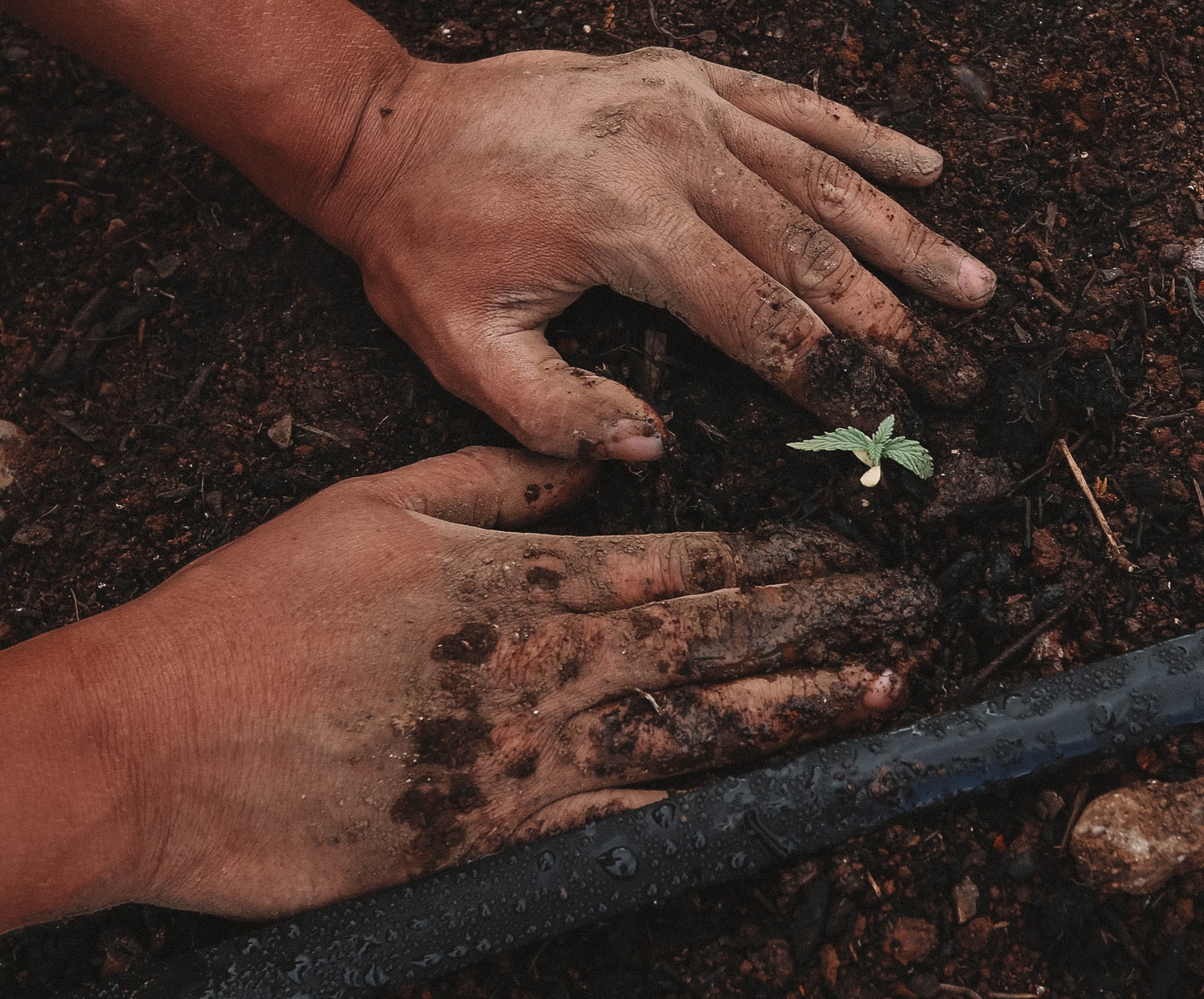Forum for the Future’s Principal Strategist in the Americas, Mary McCarthy, reflects on the state of regenerative agriculture in the US in 2022 and argues that while emerging marketplaces and recent policy interventions are encouraging, we need to fundamentally rewire the agriculture system’s structures if we are to see the deep transformation required.
Around 15 months ago, we explored what the surge in corporate commitments meant for the regenerative agriculture transformation more broadly. With the pandemic and extreme weather events continuing to affect the US agriculture sector, and new marketplaces and policy interventions gaining momentum, it’s time to take stock once more and ask: what’s the state of play for the transition to regenerative agriculture in the US?

It all starts and ends with farming communities, and the recent State of Sustainable Ag Report paints a grim picture of the reality of impact on the ground.
“As the “new normal” of a global pandemic and heightened weather, supply chain, and market extremes continues, farm financial health, profitability, and financial efficiency have all continued to decline since 2013. Despite government efforts to shore up farm financial health, farmers still feel as alone as they did in 2020 while absorbing the shock of these changes. Meanwhile, in the midst of such challenges, Field to Market’s latest National Indicators Report highlights that conservation practice adoption and sustainability outcomes have begun to reflect the strain, as continuous improvement in key environmental outcomes has plateaued in recent years.”
State of Sustainable Ag, Trust in Food and Field to Market
This underlines the reality that transitioning to regenerative agriculture in the US is a massive undertaking that requires shifts in behavior and investment from all actors connected to the agriculture system – from farming communities to retailers and brands. Harnessing early momentum around regenerative agriculture into meaningful impact requires rapid translation and learning across diverse environments and markets, between scales and regional contexts. While each regenerative farm has a unique soil, climate and culture, there are shared barriers to the transition, from perverse incentives to lack of pathways to market.
Even though there are new efforts and initiatives every day to support the transition to regenerative agriculture, many operate in the same silos as the status quo agriculture system – isolated by commodity or sector, not reflecting the diverse farm landscapes that will make up a regenerative future. Likewise, many existing initiatives address only one part of the problem – using either a soil health or social justice lens – rather than designing for multiple positive outcomes.
So, where are we starting to see these types of shifts? Two signals have emerged:
- The US Government has entered the conversation. Will intent lead to impact?
Last month, the US Department of Agriculture (USDA) made an unprecedented commitment to invest up to $1 billion to support projects that create market opportunities for commodities produced using climate-smart practices through the “Partnerships for Climate-Smart Commodities Program”. As the name suggests, the program is focused on and driven by verifiable greenhouse gas benefits which leaves questions around how these programs will ensure landscape-level ecosystem restoration including considerations for water and biodiversity.
In the same month, the USDA announced the formation of an Equity Commission, a 15-member independent commission, “charged with evaluating USDA programs and services and will recommend how we can reduce barriers for accessing them”. This is an encouraging step for an agency with a well-documented history of discrimination.
In both cases, USDA announcements demonstrate the important role the Federal Government can play in supporting a more just and regenerative agriculture system in the US.
With the renewal of the Farm Bill on the horizon, and mounting pressure on farm communities from climate change, input prices and more, it is a critical period for policy makers to support meaningful transformation toward an equitable and resilient agriculture system.
As we’ve heard consistently through the Growing our Future Policy Change workstream, farm community needs must be at the center of these new legislative efforts, and more incumbent stakeholders – particularly corporations – need to align the efforts of the Public Affairs team with their sustainability commitments.
Given the role the USDA has played in developing the agriculture system we have today, and the associated environmental and social impacts, the question remains how significant the policy shifts will be in the near term. Can they support greater transparency and more equitable distribution of value? Can they expand the goals of our agriculture system beyond yield to include the well-being of people and the planet? If so, we may see the agriculture system in the United States making strides to address the climate crisis and the revitalization of rural and farming communities.
- Ecosystem service markets come online. Who benefits?
As businesses and other stakeholders have sought creative solutions for financing the immense costs for farmers transitioning to regenerative agriculture, an abundance of ecosystem service marketplaces are beginning to emerge, all trying to capture a piece of the $13.9 billion ecosystem credit pie. In addition to early innovators around soil carbon like Nori and IndigoAg, new ecosystem service market providers are expanding their scope to include water and biodiversity impacts in an attempt to maximize environmental impact and value for the grower. Notably, the Soil and Water Outcomes fund is providing more than $31/acre on average for farmers enrolled in their outcomes-based program. “Preliminary environmental outcomes resulting from practices implemented by Soil and Water Outcomes Fund farmers are: More than 111,500 metric tons of carbon dioxide equivalents (CO2e) sequestered (a 260% reduction from baseline levels). This is equivalent to removing 24,250 cars from the road for one year.” Likewise, the Ecosystem Services Market Consortium (ESMC) will publicly launch their marketplace, after three years of research and piloting their measurement reporting and verification platform.
There is still significant concern about the use of ecosystem service markets: the science and data requirements to verify outcomes is incredibly complex, and there is a risk that, if marketplaces allow for routine offsetting, they could prop up unsustainable industries or businesses. Alongside questions of environmental impact, concerns remain about if and how ecosystem service markets will equitably reward farming communities and help them manage the risk around transitioning to regenerative agriculture systems. To this end, the Growing our Future and Cotton 2040 initiatives are working together on a regenerative cotton pilot in the US to better understand if and how ecosystem service markets can fulfill key sustainability criteria relevant to encouraging regenerative, just, resilience-building business models.
Is this enough to transform the US agriculture system?
While these emerging marketplaces and policy interventions are encouraging, what remains to be seen is the level of transformation these efforts will support. There is a significant risk that the emerging shifts in policy and financing create only an incrementally better version of the current system – perhaps supporting carbon sequestration in soils but neglecting biodiversity and community health. Progressing towards a more just and regenerative agriculture system in the US will require stakeholders from farm communities, to brands, investors and policymakers working in fundamentally different ways that create new relationships and structures within agriculture.

Current efforts still have significant gaps around meaningfully addressing land access and ownership for farmers, supporting regenerative growers to access a supportive marketplace through localized processing and distribution infrastructure, and meaningfully addressing price transparency.
As we commenced the Growing our Future collaboration 15 months ago, amidst surging corporate momentum, we asked:
How might we engage with those who have the greatest power in the current system to activate investments and empower those most impacted by the system? And how do we ensure that, as we progress this transformation, it maintains its ambition while driving the scale of change needed? And how do we most effectively bring others on this journey?
With funding from the Walmart Foundation, VF Foundation and Nestlé, Growing our Future, a system-wide initiative gathering more than 135 diverse organizations, is working to address many of these gaps and support uptake of regenerative agriculture in the US. The Growing our Future community is a space to support new relationships and learning amongst diverse, and at times disparate, agriculture system stakeholders while delivering impactful interventions within Policy Change, Financing the Transition and Pathways to Market. We continue to extend an open invitation to stakeholders from across the US agriculture system to join us in one or more of these areas of work. Opportunities to get involved range from contributing to workstream implementation, sharing your story through our communication efforts, or joining the community to learn alongside other regenerative agriculture practitioners.
If you are interested in learning more about the work of Growing our Future, please contact Mary McCarthy at m.mccarthy@forumforthefuture.org
Sources
- The State of Sustainable Ag, published February 2022 by Trust in Food and Field to Market
- USDA: Partnerships for Climate-Smart Commodities
- USDA: Equity Commission
- EWG: Timeline: Black farmers and the USDA, 1920 to present
- ESMC: Economic Assessment for Ecosystem Service Market Credits from Agricultural Working Lands
- Soil and Water Outcomes Fund environmental outcomes
- Ecosystem Services Market Consortium (ESMC)
Recommended reading
- Growing our Future initiative
- An Abundant Harvest for Regenerative Agriculture
- Growing our Future: Scaling regenerative agriculture in the USA
- Podcast: With a narrow window for innovation, will our food systems transform or unravel?
- The Innovative Business Models That Can Transform Cotton Supply Chains
Want regular insights and glimpses of the future straight to your inbox?

















Join discussion